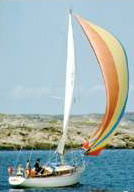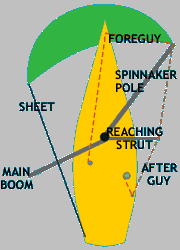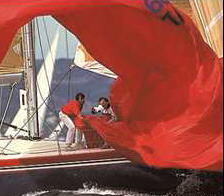VEGA SAILING SCHOOL
[Previous Chapter] [Next Chapter]
The spinnaker is like a large parachute that pulls the boat downwind. It can be set with the true wind direction anywhere from dead astern to about abeam. It's made of light nylon and adds so much sail area to the total sail plan of the boat that speed is markedly increased when a spinnaker is set.
Refer to Figure 1 and learn the various lines involved with spinnaker work. The spinnaker is hoisted by the spinnaker halyard. One corner is held in place by the spinnaker pole which is always set to windward opposite the main boom. The corner attached to the pole is the tack of the spinnaker and attached to it is the spinnaker "after guy" or more commonly, "guy." The free corner of the spinnaker has a sheet attached to it like any other sail. The only tricky thing about the foregoing terminology is that during a jibe, the pole is switched over to the new windward side and the old guy becomes the new sheet (attached to the free corner of the sail), while the old sheet becomes the new guy (running through the jaws in the end of the pole). There are two lines to hold the pole in position—the topping lift to keep it from falling when the spinnaker isn't full of wind, and the foreguy (some people call it the spinnaker pole) downhaul to keep the pole from "skying" (pointing way up in the air) when the spinnaker is full. Preparation for Setting the Spinnaker Then, holding on to the folded edges and all three corners of the sail, stuff it into whatever container the boat uses to set the spinnaker from. This used to be called a "turtle" because it was originally a plywood board covered with black inner tube rubber with an opening at one end. When the spinnaker was stuffed in it, with the three corners hanging out the open end, and placed on the foredeck of the boat near the bow, it looked like a turtle. This term has been carried over even though spinnakers are now stuffed into bags, buckets or even cardboard boxes. The halyard, sheet, and guy are then connected to the three corners. Make sure the halyard is attached to the head of the sail—the corner with the swivel. Since the spinnaker is vertically symmetrical, you can attach the sheet and guy to either of the other two corners. Make sure the sheet and guy are outside of everything on the boat (shrouds, stays, etc.) before connecting them.
The spinnaker is usually set on the leeward side. In smaller boats, where there is danger of capsizing if a crew member goes to the leeward side of the boat, the spinnaker is set to windward and pulled around the jibstay. Next, set up the pole to windward with the guy running through the outboard end. The Hoist The Set
If you follow these few basic rules you shouldn't have any trouble learning to fly a spinnaker. The Jibe We'll concern ourselves with the former since it is applicable to the type of boat most sailors learn on. The person on the foredeck stands behind the pole facing forward. Just before the jibe, the foredeck crew disconnects the pole end from the mast and from the guy at the same time. As the boat turns downwind, he or she grabs the sheet and snaps the jaw of the pole over it. Then the pole is passed across the boat and the free end attached to the mast. Meanwhile, the person in the cockpit is easing the sheet and trimming the guy as the boat turns into a jibe. This keeps the spinnaker downwind and full of air. The skipper pulls the main across and, if it is blowing hard, after the boom crosses the centerline, he or she turns the boat back downwind to keep it from broaching (rounding up broadside to the wind) which it has a tendency to do after a jibe.
The Douse
|




